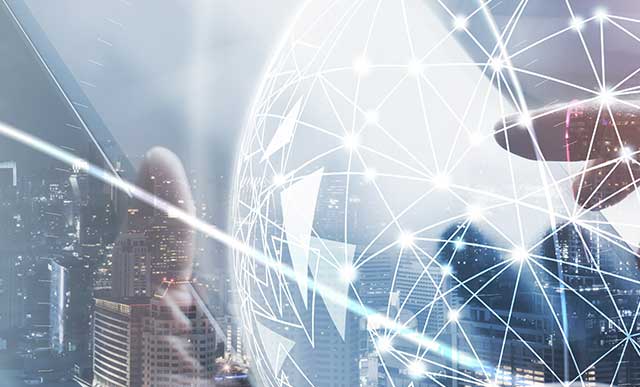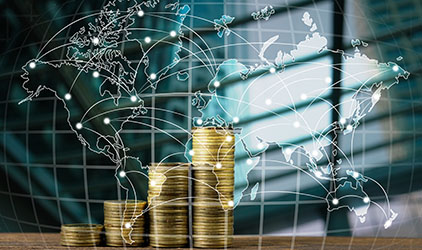Global Tax Automation for Your Enterprise
Meet the Experts
Key Takeaways
⇨ Learn how the changing global landscape is pushing the need for greater tax automation
⇨ See why countries around the world are taking a new view to tax determination
⇨ Understand the global trend of tax authorities emphasizing real-time reporting requirements
Taxes can be taxing, especially in a global landscape where rules and tax rates are constantly changing, and tax authorities around the world are pushing for real-time access to information.
For 40 years, Vertex Inc., based in King of Prussia, PA, has provided tax technology that supports companies in driving their global commerce. Vertex, with over 4,000 customers, including over 50% of the Fortune 500 — offers a range of solutions that help companies automate tax processes end to end, from tax determination to compliance. The solutions work closely with most large application providers, with SAP being its largest partner.
Recently, SAPinsider sat down with subject matter experts from Vertex to find out how the changing global landscape is pushing the need for greater tax automation. In this Q&A, Roger Lindelauf, Director, Global SAP Partnership, Vertex, and Brian Wilchusky, Director, Global SAP Partnership, Vertex, explain why countries around the world are taking a new view to tax determination — and how companies need to respond.
Q: What are the main drivers for tax automation?
RL: (Roger Lindelauf) We see a global trend of tax authorities emphasizing real-time reporting requirements. This started in Brazil and China, and other countries are now following suit. Over the next two or three years, we will continue to see a lot of countries, such as in EMEA (Europe, Middle East, and Africa), move to e-audits, e-filings, and e-invoicing. We are changing from information being pushed to tax authorities to having the information pulled by them.
This has tremendous ramifications for many organizations. In the past, companies could report their transactions to tax authorities five to 10 days after the month ended, which provided a lot of time to correct anything that went wrong with the system. Now, companies sometimes need to send the transactions immediately to the tax authorities. This doesn’t give any room to make corrections if something went wrong and can be very painful, especially for companies that do not have automated processes. For example, say you had an incorrect invoice, and you had to cancel the invoice four or five times before you got it right. Now, all the canceled invoices are sent to the tax authorities, which can become a trigger for a tax audit. If you have a fully automated tax determination system in your processes, you can avoid those issues.
Tax authorities are becoming much more data-driven and smarter about how to interrogate systems. Just because a company’s big audit didn’t result in a fine three years ago, that doesn’t mean an audit next year won’t result in a fine. COVID-19 has only accentuated this because tax authorities are focused on eliminating fraud and improving revenues. They are investing in finding the mistakes so they can collect the missing taxes. Real-time reporting allows tax authorities to detect suspicious transactions at an early stage and prevent these fraudulent activities.

Brian Wilchusky, Director, Global SAP Partnership, Vertex
Q: How can SAP customers, specifically, enhance their tax determination?
RL: Tax engines for value-added tax (VAT) determination perform automated and accurate indirect tax calculations with little to no human intervention. This reduces risk and improves audit performance. Vertex solutions deliver a global indirect tax framework that determines country-specific tax rates and rules and reliably applies them to every transaction, removing this burden from companies so they can focus on growing their business. Our research teams retrieve the latest tax rules and rates for global VAT, goods and services tax (GST), and U.S. sales tax. By continually updating tax compliance content, we keep companies up to date with the latest forms and filing requirements.
It’s important to note that those tax rates can change quickly, especially during a time such as COVID-19, which requires rapid and continual adjustments. A country might announce on Friday that it will be introducing a new tax rate on Monday. Some companies can change the rate in their systems in a day. However, others are so complex it can take a couple of weeks of checking records and interfaces to just enter a new rate into their system to make the change. There are several reasons why this is so challenging. If a country comes up with a new legal change that requires a modification to your SAP system, you often don’t have the correct specialist on board to make the change quickly. It is hard to find the right people who have all the IT and VAT skills and knowledge to build these changes into the system. In contrast, a tax technology company, which focuses entirely on this area, has experts in IT and VAT that make sure these rules are embedded into the system in a way it will always work. We have seen cases where companies did this on their own with people who didn’t really understand the changes in a specific country, and they ended up implementing the changes into their systems incorrectly.
Having this process automated provides numerous benefits for companies. There is no need for time-consuming VAT determination research and IT support to update indirect tax rates and rules across all the various ERP and billing systems. Tax calculations are backed-up with continuously updated tax content by in-country or regional research teams, keeping the engines’ VAT/GST data and rules up to date. This enables your employees to confidently manage tax data — with sophisticated validation, enrichment, and transformation capabilities — through a modern, simple UI designed for tax professionals. You can deploy your limited tax, finance, and IT resources for more value-adding, core activities.
While companies of any size can benefit from tax automation, the ideal customer would be a company that has VAT complexity. For example, the first customer to license the product was a German-based, multinational, food-and-beverage company that maintains a complex cross-border supply chain in Europe and wants to improve VAT management and accuracy. If your company has only two parties in the flow, there are not many exceptions you need to be aware of. However, if you are in the middle of the transaction, it becomes complex from a VAT point of view. If your business is a manufacturing company that assembles automotive parts for just one car company, you most likely would not be an ideal customer, for instance, but a multinational company manufacturing many different types of goods would be ideal for these solutions.

Roger Lindelauf, Director, Global SAP Partnership, Vertex
Q: How are Vertex and SAP working together?
BW:(Brian Wilchusky) Vertex and SAP have had a partnership for more than 25 years. We have over 1,000 mutual customers globally. Both of our customer sets are large multinationals. For most of the time that Vertex and SAP have worked together, we focused on the ERP side of the business. In the last several years, as SAP has made acquisitions, Vertex has expanded to bring that tax automation technology to more of the SAP solution set — including SAP Ariba, SAP Concur, and e-commerce solutions. The Vertex tax engine connects to almost any platform that generates a VAT relevant transaction. It connects multiple ERP systems and financial systems for consistency in VAT determination across a business. This enables more accurate VAT determination across sales and purchase transactions with a Vertex tax engine integrated with ERP, e-commerce, and procurement systems.
We work closely with SAP from a development standpoint, both with formal calls, as well as co-marketing. We have many touchpoints to our mutual customer base from the development all the way to bringing solutions to the field. One of the newest developments is to build a tax service capability that can provide tax determination. We’ve added some tools on top of it, called the new Vertex Indirect Tax Chain Flow Accelerator for SAP ERP, which is an integrated capability for chain flow data mapping to a Vertex tax engine. This enhances that integration and meets some of the challenges that come with tax determination. Specifically, we designed the solution to calculate sales, consumer use, and value-added taxes automatically during the invoice or checkout process. The solution enables tax professionals to connect data and documents in a chain flow transaction and process that data for consistent VAT treatment across the transaction. The product provides functionality that companies have previously needed to develop as a custom solution inside SAP systems, requiring the assistance of IT to use and maintain. The Chain Flow Accelerator makes it easy for the VAT user to manage data mapping for chain flow transactions with minimal support from IT.
RL: That is very important in this era where companies are connecting everything to their SAP platform, from billing platforms to apps. You don’t want to build a VAT determination solution into each system. It’s crucial to have one cloud-based solution that does all the VAT determination.
Q: What are some tax considerations for businesses that are deploying or planning to deploy SAP S/4HANA?
RL: Many organizations think that, in moving from their current solution to an SAP S/4HANA system, they can simply use whatever technology they built previously for VAT purposes. But the whole point of SAP S/4HANA is that it has a completely new digital core, and it requires new business processes that promote a higher level of efficiency. Consequently, you cannot move your tax determination system from SAP ECC to SAP S/4HANA without doing a thorough investigation of what you need.
The move to SAP S/4HANA is the perfect opportunity for the tax function to finally regain control and transform the indirect tax operations by implementing a tax engine. To gain the full benefits of SAP S/4HANA, change is required in your setup and from the way you used your SAP system before. If you built a lot of enhancements into your current system, you want to get rid of those enhancements when you move to SAP S/4HANA. You want to use standardization as much as possible.
All of this reflects a new view of how companies are using cloud services. If you talked to an IT architect two or four years ago and said you needed to go outside your SAP application to a cloud function, they were worried about security and didn’t want to do that. Now with the application programming interfaces (APIs) and security protocols that companies have invested in, the IT architects are changing their mindset. They are far more open to going outside their own landscape and sending data across the Internet.
The rapid changes in today’s global business, technology, and regulatory environments are having a compounding effect on the complexity of indirect tax management. Governments are expanding indirect taxation and mandating more frequent and detailed tax reporting. Businesses are entering new geographies and extending their supply chains. Technologies are increasingly capturing transaction data that impact taxable goods and services. While this dramatic shift was underway before the onset of COVID-19, the economic distress caused by the global pandemic is likely to accelerate the implementation of e-compliance requirements in most, if not all, EU member states. Thus, it is critical that business and tax leaders understand the various forms of e-compliance requirements, the key factors driving the adoption trend, and the challenges that can complicate compliance with these new rules.
To learn more, visit us at https://go.vertexinc.com/l/514851/2021-10-29/h9bb9z










